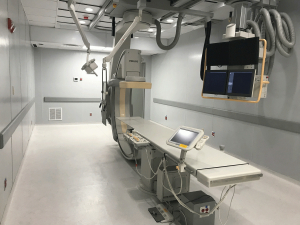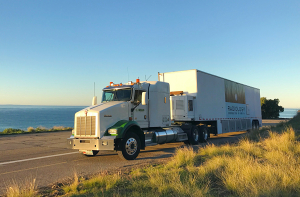Good planning — especially during a pandemic — is key in mobile imaging projects
June 08, 2020
by John W. Mitchell, Senior Correspondent
Introducing a mobile imaging unit can be a game changer for healthcare facilities. Whether the system is intended as a temporary replacement for an existing scanner, as a way to increase imaging throughput, or to bring new imaging capabilities to areas that previously could not access them—experts agree that when it comes to setting up a new site, attention to detail is critical.
HealthCare Business News spoke to some of the leading mobile imaging companies to find out what advice they had to simplify project planning.
“Build a generic site that can accommodate all OEMs and all modalities with future projects in mind,” advised Don Salyer, vice president of sales for Insight Imaging. “Do not cut corners; you wouldn’t do it on a fixed site room, so don’t do it on the foundation for mobile services.”
Salyer linked the importance of proper upfront planning to the back-end image quality, pointing out that the right solution will deliver on a customer’s performance expectations while providing safe and easy access to the mobile unit for patients and staff. Ensuring those basic capabilities are a first step toward meeting long-term revenue projections.
According to Matthew Hoover, senior manager of market development for mobile healthcare at DMS Health Technologies (Digirad), both interim and permanent mobiles require good lead time and upfront preparation to head off any potential project wrinkles.
“The earlier a customer makes their ask for specific equipment, the better the chance we have of finding any exact unit,” said Hoover. “More often than not in a permanent replacement, we can find a match, but it depends on the make and age of the equipment that is being replaced. We want their users — the techs and radiologists — to be able to hop on and have as fast a learning curve on the new equipment as possible.”
The client also needs to be clear regarding the primary goal in a replacement project. That includes thinking about if their past use will be the same as their anticipated future use and, if not, what change in specifications are required, according to Hoover. Often, a healthcare provider will be replacing technology that’s one or two decades old, which means newer systems will provide opportunities on several fronts for improving patient care and the bottom line.
We want to pair a client with the best piece of equipment to meet their needs,” added Hoover. “If it’s a unit that’s going to come on-site once a week for service — a “set it and forget it” scenario — we try to find the right price point balance to grow their business.”
Providing sufficient lead time is vital to ensuring access to the necessary equipment. Mark Koers, executive vice president of sales and marketing at Modular Devices, which specializes in mobile cardiac cath labs, reported that the inventory in the mobile market is more limited than the fixed market. He said that clients who are good planners will book specific equipment 60 to 90 days in advance, or even longer to ensure they lock in the equipment they need. But, he added, it’s not unusual for a client to reach out to them for delivery in a week or less.
“We have a fleet of 26 systems, so we’re usually in a good position to help with having a system or two readily available,” said Koers. “But the challenge with waiting until the last minute is there are limited system options, and the chances of having a preferred mobile lab system readily available are much lower."
When a hospital is replacing or upgrading multiple rooms at once, cardiovascular mobile options can offer a high level of flexibility, whereby a single unit can support more than one purpose, according to Ken Harb, CEO of Cardiac Services Mobile Inc. (CSMI). They are also easier to put in place than more permanent solutions.
“Ease of installation for a mobile is more cost-effective and less labor-intensive than either a facility build-out or a modular system,” said Harb. “Such a temporary installation allows flexibility during extensive construction projects.”
An accelerating market
Overall, mobile imaging orders — at least before the COVID-19 pandemic — to the U.S. hospital system have been trending up for the past year.
“Orders were up tremendously” from existing, new and OEM customers, Ronald Taylor, president of SVSR, which manufacturers specialty mobile imaging trailers, told HCB News. Manufacturers are requesting updates to old coaches to incorporate the latest technology, including green features related to better energy consumption.
“Our industry is getting smaller, which makes the demand ever-increasing for us," added Taylor. "The work we do is becoming increasingly vital to the industry."
Meanwhile, political and economic factors have left their mark on the mobile imaging industry. The Deficit Reduction Act of 2007 and the Great Recession of 2008 resulted in very few units being built between 2011 to 2016, according to Tom Biwan, senior director of sales for Kentucky Trailer’s custom specialty solutions.
Consequently, many pre-2006 units may be unsafe and not worth the investment to refurbish, he explained. Currently, business is on the rise and the need for new units is increasing but, according to Biwan, many of the new OEM imaging units require more stringent specifications than older mobile units can accommodate.
Insight Imaging has also seen growth, especially in the 70 cm MR market and in the higher-end CT markets, according to Salyer. GE, Siemens, and Philips have all introduced new wide-bore systems to provide full field-of-view and higher-end options that clients demand. Furthermore, he explained, PET/CT has "shown flashes of growth” with the availability of new pharmaceutical products and interest in cardiac imaging services.
“I would encourage hospitals and payers to ask if the mobile scanner they sign up to use is a certified OEM mobile product that is truly FDA approved,” said Salyer. “There are far too many companies building and supplying hospitals with devices that were altered from their original approved design and placed into mobile units. Many of these scanners are placed in coaches not designed for, or approved by the OEM for, that product.”
He added that healthcare providers need to work with their IT departments to ensure network security, which can be a "time-consuming" task.
Harb with CSMI also stressed the role of mobile providers in meeting the data security needs of their customers and HIPAA compliance standards. In a temporary arrangement, he said, that obligation starts at the commencement of the lease and also requires they protect and/or delete any data in the unit after the lease ends.
Another company currently seeing a high demand from clients is Kelly Mobile Services, which provides nationwide transport and other services for mobile imaging providers. The company also offers in-house imaging system transportation and rigging (MR, CT, PET/CT, X-Ray and cardiac cath labs) across the western half of the U.S.
“We are doing our best to keep customer rates low, but retaining quality drivers and keeping a fair profit margin is resulting in higher transport costs,” Taylor Kelly, vice president of Kelly Mobile Services, told HCB News. “We also have to account for higher costs due to operating emission-compliant trucks and increasing insurance rates.”
He recounted one assignment in which they were hired to transport MR trailers to Kodiak, Alaska, in winter. Once they arrived in Anchorage, the ferry scheduled to take them across the water to Kodiak canceled that leg of the trip. With the MR magnet running on generator power, they had to scramble to find a plug-in power source. Fortunately, they had a client hospital in Anchorage and were able to plug in for five days. Kelly hired a landing craft to move the unit between Homer and Kodiak. All told, the transport took five weeks to complete, which included extracting the old MR unit and hauling it back to California.
Mobile Imaging providers react to emergent imaging needs in the midst of the COVID-19 pandemic
Two sources report that they are responding to rapidly changing demands of their hospital clients during the COVID-19 disaster.
“Coronavirus has impacted our business, like all businesses, at this time,” said Hoover with DMS Health Technologies (Digirad). “Many facilities are looking into using a mobile provider to take their radiology department outside of the healthcare facility to provide for the imaging needs of the community, while limiting potential exposures within the healthcare setting.”
They see a keen interest in their portable solid-state gamma camera (Ergo) for nuclear medicine tests to expand their X-ray and ultrasound mobile services. Facilities are using mobile imaging units to keep patients in their vehicles until the technologist is ready to perform the exam. The tech can complete registration on the mobile unit, and then perform the scan to keep the patient out of the healthcare facility side to limit any potential COVID-19 exposure.
Hoover said that in a pandemic, normal lead planning time is not feasible.
“There are many patients that need their imaging needs addressed as soon as possible,” said Hoover. “While the focus has historically been on portable X-ray and ultrasound, we need to make sure that we are leveraging all portable modalities for COVID-19 patients. The more we can do to take the radiology department to the patient from an infection control standpoint, the better off we will be.”
Koers with Modular Devices also reported that the pandemic is rapidly changing priorities.
“The COVID-19 pandemic has had an impact on our standard business because hospitals and health care facilities have shifted their focus away from lab upgrade projects and expansions,” he said. “Projects that we had scheduled for installation in the spring have now been put off or delayed until further notice.”
However, he added that hospitals are calling to check on mobile cath units for use in outpatient-based labs. The plan is to offer cardiac imaging at off-site hospital locations, as well as placement at temporary field hospitals.
HealthCare Business News spoke to some of the leading mobile imaging companies to find out what advice they had to simplify project planning.
“Build a generic site that can accommodate all OEMs and all modalities with future projects in mind,” advised Don Salyer, vice president of sales for Insight Imaging. “Do not cut corners; you wouldn’t do it on a fixed site room, so don’t do it on the foundation for mobile services.”
Salyer linked the importance of proper upfront planning to the back-end image quality, pointing out that the right solution will deliver on a customer’s performance expectations while providing safe and easy access to the mobile unit for patients and staff. Ensuring those basic capabilities are a first step toward meeting long-term revenue projections.
According to Matthew Hoover, senior manager of market development for mobile healthcare at DMS Health Technologies (Digirad), both interim and permanent mobiles require good lead time and upfront preparation to head off any potential project wrinkles.
“The earlier a customer makes their ask for specific equipment, the better the chance we have of finding any exact unit,” said Hoover. “More often than not in a permanent replacement, we can find a match, but it depends on the make and age of the equipment that is being replaced. We want their users — the techs and radiologists — to be able to hop on and have as fast a learning curve on the new equipment as possible.”
The client also needs to be clear regarding the primary goal in a replacement project. That includes thinking about if their past use will be the same as their anticipated future use and, if not, what change in specifications are required, according to Hoover. Often, a healthcare provider will be replacing technology that’s one or two decades old, which means newer systems will provide opportunities on several fronts for improving patient care and the bottom line.
We want to pair a client with the best piece of equipment to meet their needs,” added Hoover. “If it’s a unit that’s going to come on-site once a week for service — a “set it and forget it” scenario — we try to find the right price point balance to grow their business.”
An Allura FD20 ceiling-mount digital flat panel detector interventional X-ray imaging system inside a Modular Devices mobile unit.
“We have a fleet of 26 systems, so we’re usually in a good position to help with having a system or two readily available,” said Koers. “But the challenge with waiting until the last minute is there are limited system options, and the chances of having a preferred mobile lab system readily available are much lower."
When a hospital is replacing or upgrading multiple rooms at once, cardiovascular mobile options can offer a high level of flexibility, whereby a single unit can support more than one purpose, according to Ken Harb, CEO of Cardiac Services Mobile Inc. (CSMI). They are also easier to put in place than more permanent solutions.
“Ease of installation for a mobile is more cost-effective and less labor-intensive than either a facility build-out or a modular system,” said Harb. “Such a temporary installation allows flexibility during extensive construction projects.”
An accelerating market
Overall, mobile imaging orders — at least before the COVID-19 pandemic — to the U.S. hospital system have been trending up for the past year.
“Orders were up tremendously” from existing, new and OEM customers, Ronald Taylor, president of SVSR, which manufacturers specialty mobile imaging trailers, told HCB News. Manufacturers are requesting updates to old coaches to incorporate the latest technology, including green features related to better energy consumption.
“Our industry is getting smaller, which makes the demand ever-increasing for us," added Taylor. "The work we do is becoming increasingly vital to the industry."
Meanwhile, political and economic factors have left their mark on the mobile imaging industry. The Deficit Reduction Act of 2007 and the Great Recession of 2008 resulted in very few units being built between 2011 to 2016, according to Tom Biwan, senior director of sales for Kentucky Trailer’s custom specialty solutions.
Consequently, many pre-2006 units may be unsafe and not worth the investment to refurbish, he explained. Currently, business is on the rise and the need for new units is increasing but, according to Biwan, many of the new OEM imaging units require more stringent specifications than older mobile units can accommodate.
Insight Imaging has also seen growth, especially in the 70 cm MR market and in the higher-end CT markets, according to Salyer. GE, Siemens, and Philips have all introduced new wide-bore systems to provide full field-of-view and higher-end options that clients demand. Furthermore, he explained, PET/CT has "shown flashes of growth” with the availability of new pharmaceutical products and interest in cardiac imaging services.
“I would encourage hospitals and payers to ask if the mobile scanner they sign up to use is a certified OEM mobile product that is truly FDA approved,” said Salyer. “There are far too many companies building and supplying hospitals with devices that were altered from their original approved design and placed into mobile units. Many of these scanners are placed in coaches not designed for, or approved by the OEM for, that product.”
He added that healthcare providers need to work with their IT departments to ensure network security, which can be a "time-consuming" task.
Harb with CSMI also stressed the role of mobile providers in meeting the data security needs of their customers and HIPAA compliance standards. In a temporary arrangement, he said, that obligation starts at the commencement of the lease and also requires they protect and/or delete any data in the unit after the lease ends.
Another company currently seeing a high demand from clients is Kelly Mobile Services, which provides nationwide transport and other services for mobile imaging providers. The company also offers in-house imaging system transportation and rigging (MR, CT, PET/CT, X-Ray and cardiac cath labs) across the western half of the U.S.
“We are doing our best to keep customer rates low, but retaining quality drivers and keeping a fair profit margin is resulting in higher transport costs,” Taylor Kelly, vice president of Kelly Mobile Services, told HCB News. “We also have to account for higher costs due to operating emission-compliant trucks and increasing insurance rates.”
He recounted one assignment in which they were hired to transport MR trailers to Kodiak, Alaska, in winter. Once they arrived in Anchorage, the ferry scheduled to take them across the water to Kodiak canceled that leg of the trip. With the MR magnet running on generator power, they had to scramble to find a plug-in power source. Fortunately, they had a client hospital in Anchorage and were able to plug in for five days. Kelly hired a landing craft to move the unit between Homer and Kodiak. All told, the transport took five weeks to complete, which included extracting the old MR unit and hauling it back to California.
Mobile Imaging providers react to emergent imaging needs in the midst of the COVID-19 pandemic
Two sources report that they are responding to rapidly changing demands of their hospital clients during the COVID-19 disaster.
“Coronavirus has impacted our business, like all businesses, at this time,” said Hoover with DMS Health Technologies (Digirad). “Many facilities are looking into using a mobile provider to take their radiology department outside of the healthcare facility to provide for the imaging needs of the community, while limiting potential exposures within the healthcare setting.”
They see a keen interest in their portable solid-state gamma camera (Ergo) for nuclear medicine tests to expand their X-ray and ultrasound mobile services. Facilities are using mobile imaging units to keep patients in their vehicles until the technologist is ready to perform the exam. The tech can complete registration on the mobile unit, and then perform the scan to keep the patient out of the healthcare facility side to limit any potential COVID-19 exposure.
Hoover said that in a pandemic, normal lead planning time is not feasible.
“There are many patients that need their imaging needs addressed as soon as possible,” said Hoover. “While the focus has historically been on portable X-ray and ultrasound, we need to make sure that we are leveraging all portable modalities for COVID-19 patients. The more we can do to take the radiology department to the patient from an infection control standpoint, the better off we will be.”
Koers with Modular Devices also reported that the pandemic is rapidly changing priorities.
“The COVID-19 pandemic has had an impact on our standard business because hospitals and health care facilities have shifted their focus away from lab upgrade projects and expansions,” he said. “Projects that we had scheduled for installation in the spring have now been put off or delayed until further notice.”
However, he added that hospitals are calling to check on mobile cath units for use in outpatient-based labs. The plan is to offer cardiac imaging at off-site hospital locations, as well as placement at temporary field hospitals.






